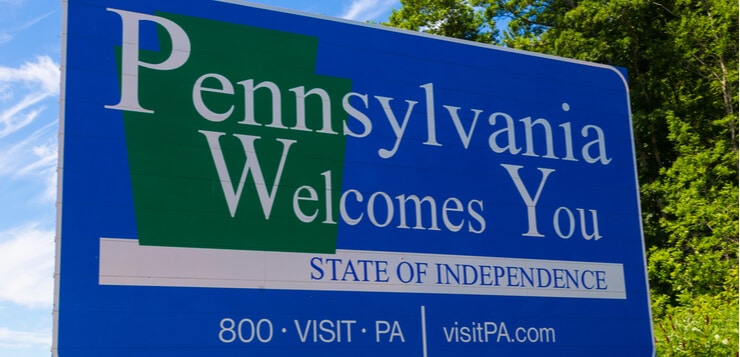It’s been a tough year for Pennsylvania’s casinos and the state government that takes a heavy tax bite out of their revenue, but maybe not as bad they might have thought months ago.
The 12 casinos recovered sufficiently from shutdowns of their physical properties throughout the spring to draw about 80% of their normal mid-summer slots and table games play.
Meanwhile, the operators are generating record-level online casino play and sports wagering. They’re on pace this year to generate at least half a billion dollars in iCasino revenue and more than $150 million from sports wagering.
Put all of that activity together with smaller amounts earned in the state from fantasy sports contests and truck stop VGTs, and more gaming revenue was generated this year than last in Pennsylvania in both July and August despite COVID-19’s impact, according to Pennsylvania Gaming Control Board revenue reports.
Three months in 2020 are among state’s highest
August’s $310.7 million in overall gaming revenue was the second highest ever in the state — behind only March 2019 — even with the 20% or so drop in slots and table play within casinos that continue operating under numerous restrictions.
Meanwhile, it is not unreasonable to expect the months of September through December to exceed that August figure and potentially set new records themselves.
Sports betting should only increase, from the addition of the NFL season and Penn National Gaming’s Barstool Sports app. If COVID concerns ease and the state lifts some of the current restrictions on casino occupancy, alcohol service, and smoking, then visitation and revenue at land-based properties should also go up.
Here are the top 10 revenue months among Pennsylvania casinos since they began operating more than a decade ago:
| Month | Gaming revenue (millions) |
|---|---|
| March 2019 | $316.3 |
| August 2020 | $310.7 |
| February 2020 | $304.3 |
| January 2020 | $302.8 |
| March 2018 | $300.5 |
| March 2013 | $296.7 |
| March 2012 | $295 |
| August 2019 | $293.4 |
| November 2019 | $292.1 |
| December 2019 | $291.9 |
As shown, three of the top four revenue months took place this year in the only three months when all casinos were open every day: January, February, and August.
The reason for those months’ profitability has little to do with what takes place within casinos, where revenue has basically been flat for years. It’s a result of the huge volume of online casino play and sports betting now taking place in the state.
More online sites means more money coming in
The state’s number of iCasino sites has grown from just the three that started in July 2019 to the dozen operating now.
Combined, they are taking in more than $50 million monthly in revenue, including August’s record $55.9 million. Their revenue in the first eight months of the year totaled $317.1 million. If they continue at a pace of $56 million monthly, by year’s end they will have netted $541 million, compared to $33.6 million in 2019.
Sports wagering, despite all the attention it receives, does not generate as much revenue as does iCasino play for operators, but it is still up substantially in 2020 over 2019 even before the new addition of Penn National’s online sportsbook.
There are both more sportsbooks than there were a year ago — Barstool this week becoming the 10th — and more public awareness of their availability and legality through the operators’ marketing campaigns.
In the first eight months of the year, the online and retail sportsbooks earned a combined $75.2 million in revenue. That compares to $28.2 million in the first eight months of 2019 and $84.1 million in all of last year.
It’s too late for 2020 revenue to match 2019
If you compare the first eight months of 2020 for all gaming revenue, combining fantasy sports and truck stop VGTs with the more well-known and lucrative forms of gambling, revenue was down year-over-year from $2.26 billion to $1.59 billion.
That’s because of the sharp loss of income in April and May, when casinos weren’t open at all, and additional drops in March and June, when only about half of normal revenue was generated.
| Month | 2020 (2019) Slots revenue in millions | 2020 (2019) Table Games | 2020 (2019) iCasinos | 2020 (2019) Sports wagering | 2020 (2019) Total gaming revenue |
|---|---|---|---|---|---|
| January | $190.3 ($179.8) | $72.6 ($74.4) | $14 (0) | $22.8 ($2.6) | $302.8 ($259) |
| February | $199.7 ($190) | $77.4 ($74) | $19.5 (0) | $4.7 ($1.9) | $304.3 ($267.6) |
| March | $87.6 ($226.6) | $33.1 ($82.5) | $24.3 (0) | $6.9 ($5.5) | $153.5 ($316.3) |
| April | 0 ($200.4) | 0 ($77.4) | $43.1 (0) | $2.9 ($4.2) | $46.1 ($283.9) |
| May | 0 ($209.6) | 0 ($76.6) | $55.8 (0) | $4.8 ($2.9) | $61 ($290.8) |
| June | $62.4 ($198.8) | $11.7 ($68.9) | $50.1 (0) | $6.7 ($2.1) | $132.6 ($271.3) |
| July | $165 ($199.6) | $52.5 ($77) | $54.4 ($0.8) | $8.1 ($2.9) | $283.1 ($281.5) |
| August | $167 ($206.3) | $65.1 ($76.2) | $55.9 ($3.4) | $18.3 ($6.1) | $310.7 ($293.4) |
Even if September through December surpass prior monthly highs, with perhaps $320 million to $325 million a realistic revenue figure each month, there is no chance to match 2019’s annual revenue of $3.41 billion.
The state could potentially approach $2.9 billion in revenue, however, which is not nearly as devastating as might have been anticipated in the spring when no one knew the extent to which patrons would return to casinos upon reopening.
And that doesn’t have meaning just for the casinos, but also for the state and its citizens — non-gamblers included — considering Pennsylvania relies more heavily on gaming taxes than any other state.
There are different tax rates for each form of gambling, and the revenue is allocated to various purposes rather than just the state’s general fund: real estate tax reduction, economic development projects, support for the horse racing industry, and more.
When all of the tax rates are blended together, they amount to about 42% of the overall revenue, meaning $1.42 billion from last year’s $3.41 billion, with a small amount of that going to local governments also.
Those total taxes are headed to something more like $1.2 billion in 2020 — an annual decline of some $200 million — if our estimate of $2.9 billion turns out to be the revenue figure.
That’s a tough pill to swallow among all of the other negative COVID-19 impacts, and state lawmakers and the Wolf administration will need to wrestle this fall with how to adjust the 2020-21 budget accordingly. The good news is it’s not as bitter a pill as would have been the case without adoption of sports wagering and online casinos in Pennsylvania.
Photo by Shutterstock






